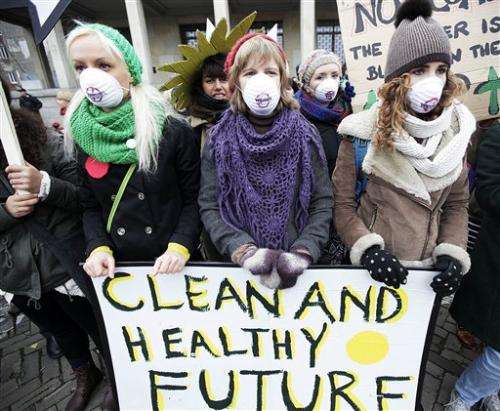A glance at coal and its role in climate change

Coal took center stage in the global warming debate on Monday as a high-profile coal industry event kicked off on the sidelines of a U.N. climate conference in Warsaw.
Environmental activists were outraged, saying coal is the problem, not the solution to climate change.
Poland, which is presiding over both conferences, says the coal industry needs to be part of the climate discourse because a lot of coal-reliant countries—Poland included—will depend on the fossil fuel for a long time.
Here are some quick facts about coal and the carbon pollution the world is releasing by burning it:
WHAT IS COAL?
Coal is a fossil fuel that formed over time from the remains of plants that died millions of years ago. It contains energy that those plants once absorbed from the sun.
WHY DO SOME PEOPLE CALL IT A "DIRTY" FUEL?
Apart from being a major contributor to emissions of CO2, the most important greenhouse gas, coal is a leading cause of smog, acid rain and air pollution. Governments have been trying to manage the environmental impact of coal burning ever since smoke pollution became a major problem in English cities in the 19th century.
HOW MUCH CO2 EMISSIONS COME FROM COAL?
Of all energy sources, coal is the dirtiest in terms of carbon pollution. In 2011, about 44 percent of total energy emissions came from coal, compared to 35 percent from oil and just over 20 percent from natural gas, according to the International Energy Agency.
HOW CAN YOU REDUCE EMISSIONS FROM COAL?
U.N. climate chief Christiana Figueres offered one alternative Monday: leave the coal in the ground. But the reality is a lot of countries with coal resources are not ready to give it up as an energy source. Instead, they are looking for ways to reduce emissions by improving the efficiency of coal-fired plants or adopting technologies that trap the CO2 for storage underground. These technologies are expensive and have so far not been put to widespread use.
IF COAL IS SO DIRTY WHY ARE WE STILL BURNING IT?
Since the industrial revolution coal has been a double-edged sword for humanity, powering economic growth while polluting the environment. Even now that the climate impact is known, coal-reliant countries are reluctant to give it up, fearing it would hurt their economies. Even though China—the world's biggest carbon polluter—is investing in renewable energy, its coal use is also rising because of the huge demand for energy as its economy expands, lifting millions of people out of poverty.
WHO BURNS THE MOST COAL?
China is the world's biggest producer and consumer of coal. Coal accounted for 68 percent Chinese energy consumption in 2012, according to the Center for International Climate and Environmental Research, Oslo. The U.S. also is a top coal producer, but domestic coal use is declining as some power plants have switched to lower-priced natural gas.
© 2013 The Associated Press. All rights reserved.



















